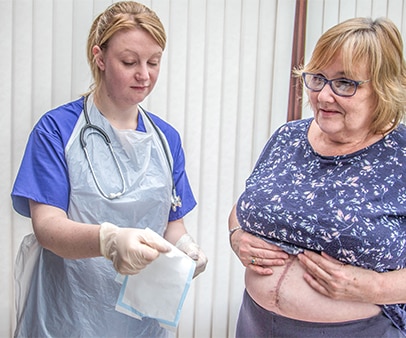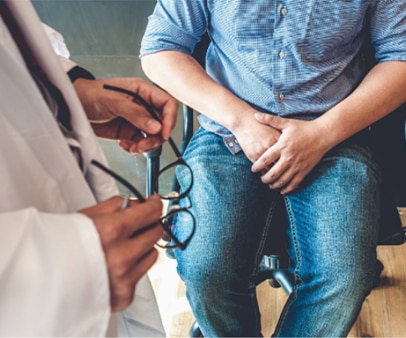
About Ventral Hernias: Common Symptoms, Potential Causes, Diagnosis, and Treatment1
A ventral hernia is an umbrella term for a protrusion of intestine or other tissue through a weakness or gap in the abdominal wall. The most common types of ventral hernias are:
- Umbilical Hernia: Umbilical hernias may appear as a bulge or swelling near the belly button that becomes more noticeable when you cry, cough, or strain.
- Incisional Hernia: An incisional hernia appears at, or in close proximity to, a surgical incision (usually 3-6 months post-surgery) through which an intestine, organ, or other tissue protrudes.2,3
Common Symptoms of Ventral Hernias4
- Laughing or crying
- Coughing or sneezing
- Pooping or straining
- Bending or lifting
- Exercising
It’s possible you may feel it when it “pops out” or when you move in a way that pulls, compresses, or pinches it. It might feel like a tug, a dull ache or a sharper pain. Contact your healthcare provider immediately if you experience adverse symptoms/complications, including:
- Fever or chills
- Nausea or vomiting
- Redness/rash at the site
- Difficulty urinating or passing a bowel movement
- Increased pain, swelling, redness, tenderness
- If your hernia looks bigger or can’t be pushed back inside
Potential Causes of Ventral Hernias1,4
Ventral hernias may occur for any number of reasons, including a weakness already present at birth or from injury, surgery, gradual wear and tear, or underlying health conditions. The most common contributing factors are:
- Chronic or severe coughing or vomiting
- Manual labor that involves heavy lifting or pushing
- Abdominal injury or surgery
- Aging and natural muscle degeneration
- Chronic obesity
- Pregnancy and childbirth
- Chronic constipation
- Congenital birth defect
- Connective tissue diseases
- Diabetes
- COPD, emphysema, or other breathing-related disorders
Complications of Ventral Hernias
In some instances, a hernia may become incarcerated, which means the abdominal content is trapped and can no longer be pushed back into its natural place. Hernias may also become strangulated, where the blood flow is cut off, which may cause severe pain; nausea or vomiting may also develop. If you have any of these symptoms, seek immediate medical attention.5
Ways to Diagnose Inguinal Hernias1,2
To identify whether or not you have an inguinal hernia, your healthcare provider will likely begin with a physical examination. During the exam, you may be asked to stand and cough to make the hernia appear bigger. If the hernia isn’t visible from the outside, imaging tests including an ultrasound or CT scan may be performed.
Additionally, they may perform blood tests or use one or more diagnostic tests, such as a(n):
- Ultrasound
- CT scan
- MRI
Treatments for Ventral Hernias1
Specific treatment for a ventral hernia will be determined by your doctor and depends on multiple factors including your general health, anatomy, extent and location of the hernia, and desired level of future physical activity. Depending on these factors, your doctor may advise you to "watch and wait," but it’s important to know that hernias will not heal on their own; surgery is required to repair a hernia.
Surgical Treatment
There are three primary surgical options for hernia repair: open, laparoscopic, and robotic. The appropriate type of surgery for you may depend on the size, severity, and location of your hernia. Ask your doctor about which option is right for you.
- Open Surgery: As the traditional surgical method, an open surgical procedure involves making a large incision over the area of the hernia. The hernia bulge is returned to its correct position and a mesh is often placed to help strengthen and support the weakened area before closing up the incision.
- Laparoscopic Surgery: A surgeon will use several small, key-hole sized incisions during laparoscopic surgery. Instruments, such as a camera, are then inserted through the incisions to perform the operation.
- Robotic Surgery: Similar to laparoscopic surgery, robotic surgery uses several smaller incisions. The surgeon performs the operation from a console located in the operating room.
Learn more about surgical techniques here.
What Are the Next Steps to Treat a Ventral Hernia?
If you have symptoms of a ventral hernia, contact your healthcare provider as soon as possible to have it diagnosed and/or to rule out other possible causes of pain.
The guidance provided in this article follows general rules that should be discussed with your doctor. This article is for informational and educational purposes only. It does not substitute for medical advice. If in doubt, always consult your doctor.
Related Articles
Join the HerniaInfo.com community! Get notified about our latest articles and updates on all things hernia as they become available.
References
- https://www.hopkinsmedicine.org/health/conditions-and-diseases/hernias/ventral-abdominal-hernia
- https://www.healthline.com/health/incisional-hernia#causes
- https://www.hopkinsmedicine.org/health/conditions-and-diseases/hernias/incisional-hernia
- https://my.clevelandclinic.org/health/diseases/16531-ventral-hernia
- https://www.healthline.com/health/strangulated-hernia#symptoms
This site is not intended as a substitute for professional medical care. Only your physician can diagnose and appropriately treat your symptoms. BD does not recommend the use of any particular physician or team of physicians. Please consult your healthcare provider for advice regarding who should be part of your hernia repair team.
BD-115954 (3/24)


